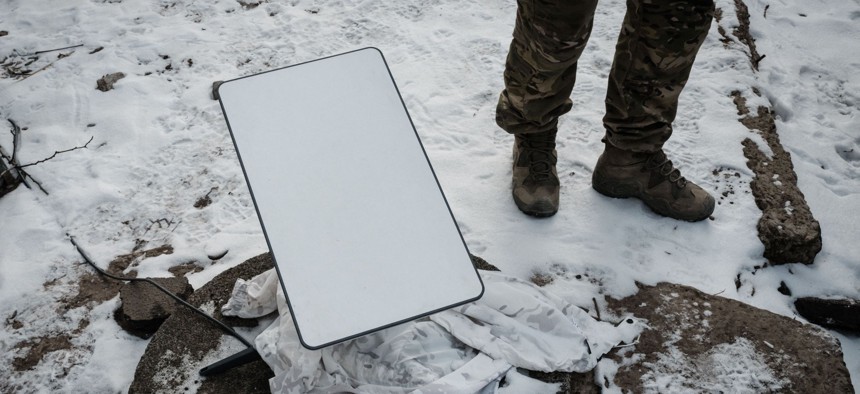
A Ukrainian serviceman stands next to the antenna of the Starlink satellite-based broadband system in Bakhmut on February 9, 2023. YASUYOSHI CHIBA/AFP via Getty Images
How Elon Musk's Starlink is Still Helping Ukraine's Defenders
Portable sat-comm gear feeds drone video to artillery batteries—and more.
NEAR BAKHMUT, Ukraine—In a crowded basement just a staircase away from their sleeping quarters, the men and women of Ukraine’s 93rd Brigade “Seneca” drone unit waited for video feed of targets to appear on a bank of wall-mounted screens near this eastern Ukrainian city half-encircled by Russian forces.
The scene would hardly look out of place at any U.S. military operations center. The imagery streams, though, weren’t coming from state-of-the-art drones over communications networks costing tens of thousands of dollars. They streamed in from commercial drones via what soldiers describe as a key node to their work: Starlink satellite internet devices.
A Starlink set-up, consisting of a plain white 19-by-11-inch dish, is visually unremarkable. In the right hands, though, it’s the linchpin to a kill-chain that links Ukrainian artillerymen to their Russian targets.
The Starlink and the technologies it enables are a “black swan” that have helped Ukraine wreak unexpected havoc on invading forces, said a 38-year-old soldier with the callsign of “Blockchain.” Russian forces have taken enormous casualties in their attempts to capture Bakhmut, Ukrainian leaders say. Soldiers from Seneca saying they’ve seen evidence of Russia appearing to force their soldiers to fight by machine-gunning those who retreated.
Like many soldiers interviewed for this article, Blockchain requested that he be identified by his call-sign for security reasons.
The Seneca unit, staffed by an eclectic mix of long-term soldiers and ex-coders, journalists, and construction workers, accomplishes a wide range of tasks for the 93rd Brigade.
Perhaps most prominent is their work dropping jury-rigged bombs from drones. A soldier by the callsign Lebed showed off two mortars used for the work at Seneca’s base, which he said were captured from the Russians. “They’re just a chunk of iron” now, said the 31-year-old former journalist, miming knocking them against the wall. Videos of the drone bombings are popular online, garnering hundreds of thousands of views.
The core of Seneca’s work, though, is surveillance. Working 24/7 from a command center and from positions close to Russian lines, drone operators help identify targets for Ukrainian artillery, and then observe and correct their fire.
Like any soldier, the drone operators select their weapons based on their tasks. For night observation, Seneca will fly a large DJI Matrice 30T, a $13,000 drone equipped with a thermal camera. For basic observation, they may choose to use a $2,000 DJI Mavic 3 quadcopter drone, typically flying these within a kilometer or two from the Russians. Seneca also uses winged drones like the Valkyrja, a Ukrainian-made drone launched by bungee cord, that can stay airborne longer and fly farther than a typical DJI quadcopter.
The drones are far from ideal, of course. Poor weather conditions, like snow or rain, can short-circuit them. If drone operators fail to turn off certain settings, a DJI-brand drone can be forced to reveal its operator’s location by Russians using software originally designed to enable police departments to hunt criminals.
Still, drones are deadly effective. “Student,” a 37-year-old soldier who learned to fly drones in the construction industry, said that strikes he had participated in from August to December killed 600 Russian soldiers.
Blockchain said the Ukrainian kill-chain depends on linking commercial drones to the units they support, often through videochat software like Google Meet or Zoom. Without Starlink, such operations would be impossible, as cell networks in combat zones are often out of operation or unreliable.
For many models of DJI drones, DJI allows operators to use their own phones or tablets as controllers to operate the drone. If the controller is an Android model, the drone footage can then be easily shared via Google Meet. The Ukrainian artillery team merely has to receive an invite to the “meeting” and instantly has a live feed of where their rounds are landing.
If there’s any problem, Blockchain said, they just create a new meeting. There aren’t many security vulnerabilities, he believes, given how strong Google security is. “Good luck hacking Google,” he said. “They have way better security than the Pentagon.”
Certain drones, like the DJI Matrice 30T, don’t allow users to swap in Android-based controllers, meaning that operators have to jury-rig solutions with Zoom, a less-than-ideal solution, Blockchain added.
Starlink, of course, has its issues.
Run by billionaire Elon Musk, the company stated on Feb. 9 that it would limit the Ukrainian military’s use of Starlinks for offensive operations. On Feb. 14, soldiers in Seneca reported having had problems for two days previously but said those had been resolved.
Jamming is also theoretically a problem, said Todd Humphreys of the University for Texas at Austin. Each Starlink terminal uses an internal GPS receiver to help choose which satellites to transmit its signals, so Russian efforts to jam GPS signals can interrupt Starlink operations. In March, Starlink engineers quickly fixed a Russian electronic warfare attack through a code update, U.S. officials said in April.
Other problems are more prosaic. Before setting out for the front lines on the morning of Feb. 14, the unit had to find a Starlink device whose account was fully funded. Accounts cost $75 a month, and are sometimes paid out of pocket by volunteers supporting the Ukrainian military.
The soldiers of the Seneca unit, of course, don’t have time to sit back and pick their technologies at leisure. Amid 24/7 combat operations, every minute is given over to operations, analysis, and training, said Gray, a 24-year-old soldier who manages the video feeds.
“We have no problem with motivation,” said Lebed, a former journalist who went from covering Ukraine’s war in eastern Ukraine to fighting in it. “But it’d be good to sleep.”




